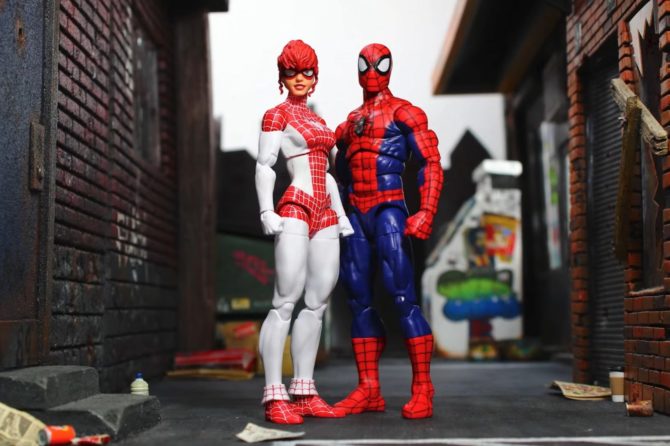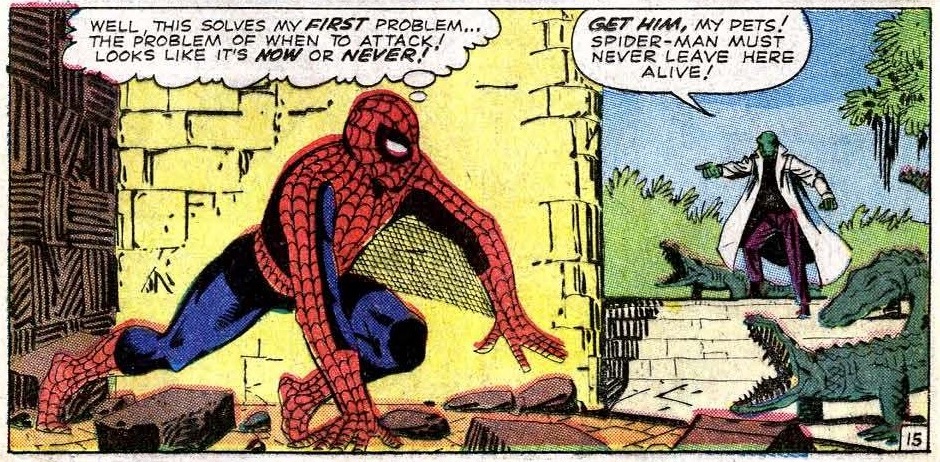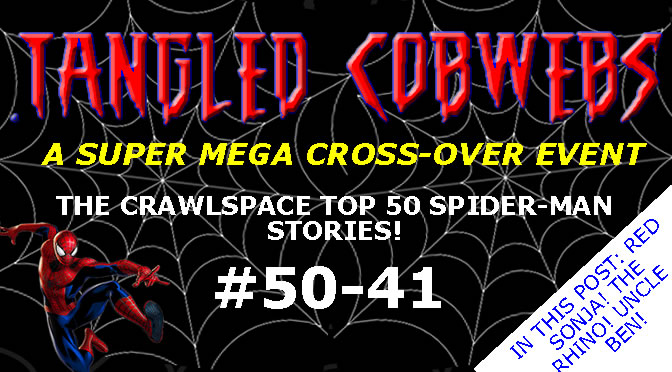Marvel is celebrating the 60th anniversary of Spider-Man with this week’s Amazing Fantasy #1000. This means it’s also the 30th anniversary of the 30th anniversary, which was a pivotal event for some Spider-Man fans.
These had coverdates between June-September 1992, which was a few years before I got into Spider-Man; I was six at the time. But these were accessible back issues that stores ordered a lot of, so when I did start regularly going to comic book stores, I’d find these in the back issue bin at reasonable prices with stories involving major bad guys, back-up material to show what the supporting cast had gone through, gatefold posters and commentary. I haven’t read most of it in years, so I’m curious if it holds up. One immediate highlight is the hologram covers, which were also released separately. Those are nifty.

I’m looking at these stories in the order in which these were published.
Spectacular Spider-Man #189: The most important issue was a major part of JM DeMatteis and Sal Buscema’s Harry Osborn saga. This worked as a standalone comic (reprinted in The Very Best of Spider-Man; top ten on your list) and part of the larger two-year storyline. In this story, Harry becomes a different type of villain than anyone Spider-Man has fought. I can see why he’s some fan’s favorite Spider-Man enemy, and that this issue is his highlight. I wouldn’t say that this is the peak of Spider-Man rogues, which arguably makes it the peak of supervillainy, but a discerning reader could reach that conclusion.

There’s a reason that two of the film versions of Spider-Man adapted the Harry Osborn saga. He torments Peter in a way like no other. He’s too rational to be manipulated, but dangerous enough that he can put innocents at risk. He also represents the character development over the years. Harry may not be a better man than when he was introduced, but he is now a different man. He has become Norman, so he represents the dark side of the theme of growth in the Spider-Man comics.
Two aspects hold up really well. DeMatteis has a cinematic style of writing, which would dominate comics within a decade. That requires an artist with the storytelling skills of Sal Buscema, but fortunately we’ve got that. The early 90s coloring style is considered notoriously ugly now, but it works really well with Buscema’s style. It could also be that colorist Bob Sharen knows what he’s doing, or that a veteran artist like Buscema knows how to complement the printing quality of the time.

This is a tense story. I love the sequence where MJ tries to keep May safe. Molten Man has never been better. It’s also just one of the suspenseful situations for Spider-Man, where his secret identity is at stake, and he has to make his peace with the inevitable revelation. When he can’t dodge a goblin glider, he has to risk impalement.
A five page back-up story with Aunt May is exceptional. It reveals character, and sells a major epiphany, well-earned in the context of a recent adventure, and potential foreshadowing of revelations in Amazing Spider-Man #400 (later retconned.) Artist Bob McLeod (whose best known collaboration with DeMatteis was when he inked Kraven’s Last Hunt) imbues May with dignity and wisdom. It’s just an example of how the psychological depth of DeMatteis is unparalleled in Spider-Man.
Web of Spider-Man#90: Alex Savuik had been the regular artist on the title for several years, but Howard Mackie had just come on board with the “‘Name of the Rose” six-parter, so a big anniversary issue was his second Spider-Man story. He did end up sticking with the character for a while. Because there’s no back up in this issue, the main story “The Spider’s Thread” is the longest of the group.

After a weird encounter with Galactus, Spider-Man finds himself in a seemingly different world where he’s still a celebrity, and Max Shiffman is still his agent. This is a narrative that’s sensible for a big anniversary issue, taking a look at how some characters have changed.
Savuik’s art style takes some getting used to. He has a tendency to do splash pages and big panels at the cost of storytelling, which is a problem in a story that is often confusing- it opens with Max in a room with Spider-Man memorabilia, alternating to flashbacks with his early encounters with real Spider-Man, so it’s sometimes unnecessarily complicated for a reader to get their bearings, which may be intentional in a story where Spider-Man is trying to get his bearings. I don’t think the garish 90s coloring is a good match for Savuik’s style, although he does okay with an easy layup in a story where Spider-Man hallucinates encounters with a mix of Marvel characters and A-list rogues.

This is a story we’ve seen before and seen better; the best take was probably DeMatteis with his Chameleon saga a few years later, and other artists have been able to take more advantage of flashbacks and hallucinations. However, it does say something about Spider-Man’s character and how things could’ve gone for him. It’s not a shame that Savuik jumps where Ditko, Kane and the Romitas have flown. There is a decent twist with Max Shiffman that provides pathos for an obscure character from the most important Spider-Man story ever. The end result is not out of place with the other celebrations.
B
Amazing Spider-Man #365: The Amazing Spider-Man anniversary issue was the biggest and most expensive, with 80 pages of material.

The main story “Fathers and Sins” brought back the Lizard after “Torment”—incidentally the best-selling Spider-Man comic book ever. This has been reprinted in The Very Best of Spider-Man, although that’s more because it’s a standalone story by a top creative team with one of the major villains.
It’s an okay Lizard story, where the characters are largely acting rationally in ways that build on their history. Curt Connors has a bit more control over the Lizard, and is willing to take some extreme risks for a cure. Billy Connors has an arc, wanting to end the menace that has threatened his family. A secret underground lair of Doctor Octopus’s plays into the narrative, which is a nice touch. Spidey’s got some good jokes.

One problem with the Lizard is that he’s often written as if he’s the Hulk, and the things that make him special are neglected. The main thing that distinguishes him is the emphasis on his family. The story with Billy is legitimately moving, and there are some nice details that make the Connors family seem lived in, starting with Martha’s surprise for her son on his birthday and Peter’s worry about that.
A centerpiece in the issue is a transparent effort to replicate the iconic moment from Amazing Spider-Man #33, where Spider-Man is trapped under a great weight and has to push himself to the physical limit to do the right thing. It’s done okay here. Some differences are that the moral stakes are unique (Spider-Man has to stop a good man from risking his life but he’s aware that it may be for the best if Connors is left to his own devices) and that Spider-Man still has to use his intellect.
The cliffhanger ending brings back Peter Parker’s parents; that ultimately did not go well. Stan Lee returns for a commentary on the decision to reveal that they were SHIELD agents in Amazing Spider-Man Annual #5, and he cowrites a John Romita Sr back up story with MJ remembering the moment she could have broken up Gwen Stacy and Peter Parker, which is perfect for an anniversary issue. It is a gift to get that from Romita Sr.

Critic Peter Sanderson adds some commentary on how the character has changed. We get the first five pages of Spider-Man 2099. Tom Defalco and Todd Smith tell a brief Prowler story which is an odd choice for the issue, but ends with a legitimately moving discovery about a bystander. David Michelinie & Aaron Lopresti present J Jonah Jameson’s take on the origin of Spider-Man, which works pretty well in terms of what he understands about Spider-Man and what he doesn’t.
A- for the entire issue (including the back-ups and extras), B+ for “Fathers and Sins”
Spider-Man #26: The Spider-Man monthly was one of Marvel’s best-selling titles, and curiously more expensive than the other Spider-Man comics (the anniversary issue was $3.50, fifty cents more than the other 48 page anniversary specials.) It started as a vehicle for Todd McFarlane, but he left for Image Comics. And then it became an opportunity for previous talent to return for standalone stories. Fellow Image founder Erik Larsen wrote and illustrated “The Revenge of the Sinister Six.” Ann Nocenti would return for a follow-up to the Mad Dog Ward saga, Punisher writer Steven Grant would write a Punisher team-up and JM Dematteis would do a three part Electro story.

So it makes sense to get people who have told a lot of Spider-Man stories on this issue with Tom DeFalco writing the main story, joining artists Mark Bagley and Ron Frenz, along with a bevy of inkers. The main story is a contrast with the others. There’s no A-list villain. A shmuck steals an experimental force field from criminals and causes all sorts of trouble including a flying motorcycle. It’s not life and death (except for the shmucks who made the wise decision to steal from career criminals), although there are still practical considerations for Spider-Man. It feels a bit filler, but it’s not derivative. There is an obvious twist with a purse-snatcher wondering what direction to take his life, but that works pretty well to connect everything to the beginning.

A back-up by Defalco and Bagley covers how the spider-sense works. It’s decent character-based exposition. A similar sequence in the main issue has Peter recalling his origin. Fans have seen that dozens of times (hell, we had it in other situations during the anniversary), but there is an added gravitas when an older Peter Parker is looking back at some of the most pivotal moments in his life. The nods to the origin in different ways help makes all the stories seem to be part of a larger package, even if this one comes across as rushed, right down to the perfunctory closing splash page.
B+
This could be a decent TPB, with the four main comic book stories, assorted back-ups and the commentary from Marvel Age #114 on Spider-Man’s anniversary and the making of the hologram covers.
It is interesting to look at this period of the Spider-Man comics and what works and what doesn’t. It’s telling that the focus on Peter Parker is much more limited. We get back-ups with Aunt May and Jonah, but no scenes where they interact with Peter. He’s mainly there to be in situations where Spider-Man’s going to be needed like going to Billy Connors’ birthday party before the Lizard shows up, or going on a walk with MJ before a guy in a force field runs past yelling for help. A former member of his supporting cast has become a major villain, and the surprise family members also end up being part of a supervillain plot, so Peter Parker’s main problems seem to be the intrusion of Spider-Man’s world into his. It could be that this the anniversary issues are an unrepresentative sample since it’s limited to shorter comics and that we see more balance between Peter Parker and Spider-Man in annual-length or multi-part stories, although that doesn’t match my recollections.
These issues are still the gold standard in terms of how anniversaries should be celebrated in comics. Each issue was self-contained but made an effort to say something important about the character. There were nods to the origin and to the major moments of the series. We got standalone fights with A-list villains, and another adventure that gets to a different side of the character.
Did I say gold standard? With the great covers, silver standard may be more appropriate.









